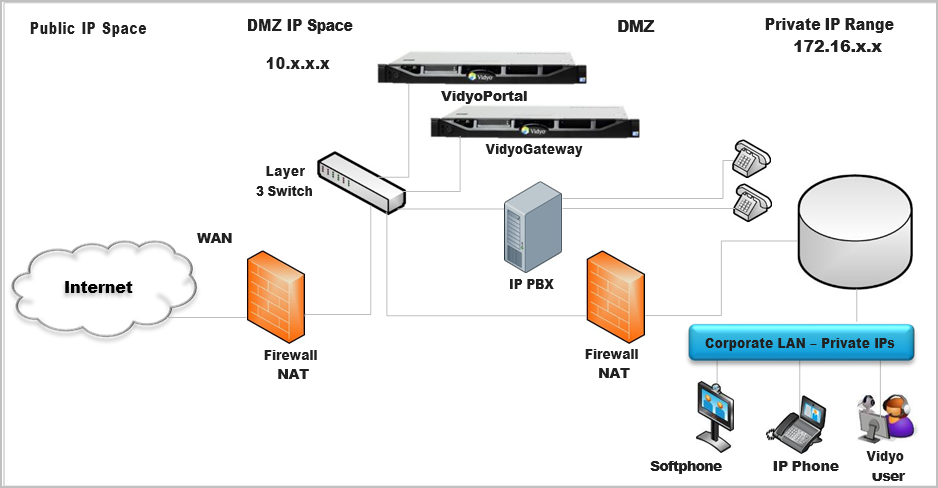7. Integrate VoIP phones and IP PBXs
At times you may want to add voice-only participant(s) into a video conference through an existing VoIP phone system. This section provides an overview of integrating VidyoGateway with VoIP phones and IP-based PBX systems.
Each VidyoGateway supports up to 50 simultaneous voice-only connections. Additional capacity can be achieved by clustering VidyoGateways.
The VidyoGateway supports G.711 and G.722 (narrowband and wideband) audio codecs commonly used by VoIP systems, and the SPEEX codec used on the Vidyo side. The VidyoGateway supports H.323 and SIP signaling as well as Vidyo’s signaling format, which is based on SIP but enhanced to enable additional capabilities.
As calls are placed in either direction, the VidyoGateway performs transcoding between codecs, converts signaling, and enables Vidyo endpoints and VoIP phones to participate in the same conference or point-to-point call.
Network topology
The diagram below illustrates a typical network topology for VoIP integration with Vidyo's video conferencing. Elements include VidyoPortal, VidyoRouter, VidyoGateway, an IP PBX, analog POTS phones, VoIP soft phones, dedicated IP phones, Vidyo endpoints (such as VidyoConnect).
Connect to video conferences from VoIP phones
If you are using a soft phone or IP phone that supports the ability to place calls directly using a SIP dial string, you can call into a video conference directly (without needing an IP PBX). The SIP dial string must include three components:
- The voice-only service prefix of the VidyoGateway.
- The extension of the endpoint or meeting room you are calling.
- The address of the VidyoGateway.
For example: This dial string 91234@10.10.99.1 would route a voice call (9) to extension 1234 to the VidyoGateway at IP address 10.10.99.1. Depending on the configuration of the VidyoGateway service prefix, the call connects to either the Vidyo user’s meeting room or ring the endpoint with extension 1234 directly.
Connect to video conferences via an IP PBX
IP PBX systems allow for various call routing rules that determine how calls are connected. There are many different possible permutations for setting up how calls are connected from telephone to the VidyoConference. The following bullets describes two common methods for call routing on the IP PBX.
- Connecting to an IP PBX with a Direct Dial Number: With this method, the IP PBX is configured with a dedicated PSTN telephone number that is exclusively used for voice participants joining video conferences. This number brings callers into an IVR (interactive voice response) system hosted on the IP PBX that prompts them for the Vidyo user extension. Once the caller has entered the extension, the IP PBX forwards the call out the SIP trunk to the VidyoGateway. Ideally, the extension entered at the IVR prompt matches the destination Vidyo extension and the IP PBX prepends the VidyoGateway voice-only prefix.
- Connecting to an IP PBX with an Extension Dial: A second method is to treat each Vidyo user as another extension—like a desk phone extension. You do this by assigning a block of extensions to the VidyoGateway trunk. When creating a user account on the Vidyo system, each user is assigned one of the valid extensions. When users then call into the PBX from a telephone and have the option to enter an extension, they can enter one of the Vidyo extensions which then routes the call through the SIP trunk to the VidyoGateway. The IP PBX is configured to route any extension in this range to the VidyoGateway with the VidyoGateway voice-only prefix prepended.
